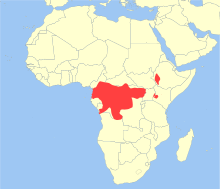De Brazza's monkey
| De Brazza's monkey[1] | |
|---|---|

| |
| Scientific classification | |
| Domain: | Eukaryota |
| Kingdom: | Animalia |
| Phylum: | Chordata |
| Class: | Mammalia |
| Order: | Primates |
| Suborder: | Haplorhini |
| Infraorder: | Simiiformes |
| Family: | Cercopithecidae |
| Genus: | Cercopithecus |
| Species: | C. neglectus
|
| Binomial name | |
| Cercopithecus neglectus Schlegel, 1876
| |

| |
| Geographic range | |
De Brazza's monkey (Cercopithecus neglectus) is an
Etymology
Locally known as swamp monkeys, these primates are named after the Italian naturalist and explorer Jacques Savorgnan de Brazza.[3][4] Their scientific species name, neglectus, which means to pay no attention to, was given to them because of their ability to hide from both humans and predators.[5]
Description

The De Brazza's monkey is the most
Ecology
Distribution and habitat
De Brazza's monkeys range across the swamps, bamboo and dry mountain forests of Angola, Cameroon, Central African Republic, Congo, Democratic Republic of the Congo, Equatorial Guinea, Ethiopia, Gabon, Kenya, South Sudan, Nigeria and Uganda and possibly Tanzania though reports have not been confirmed.[9][2][10] Troops are found almost exclusively near water, rarely venturing farther than 1 km away from a river or tributary. As a result, they can sometimes be seen swimming.[6][7] The monkeys prefer dense forest and vegetation, only venturing into more open forest to feed. They are mainly arboreal, but descends to the ground to feed on herbaceous plants.[6][2] Due to its cryptic nature there is no accurate population estimate for the species over its entire range.[8]
Diet
The diet of De Brazza's monkeys consists mostly of herbaceous plants found on the forest floor, and fruits when available. These are supplemented with insects, seeds, and other food sources when primary foods are scarce.[7]
Predators
Predators of the De Brazza's monkey include the
Behavior

The lifespan of the De Brazza's monkey is thought to correspond similarly to other members of
Male De Brazza's monkey communicates with booming sounds. These are usually heard early in the morning when the male calls out to establish his territory, though he will also use this call to bring the group back together if they get separated.[6][7] When attacked by predators, males will give an alarm call. In the case of crowned eagles, males will emit a short bark before attacking the eagle to scare it off. Females have also been observed to give alarms calls and growl at humans. Otherwise, female vocalizations are limited to quiet croaks given when feeding or resting. Infants and juveniles will give shrill squeals of distress when separated from their mothers or the group.[7] Given the cryptic nature of this species, hearing their calls is sometimes the only way to know they are present.[12] Unlike other guenons, which often form polyspecific associations to decrease predation and increase foraging, DeBrazza's monkeys will be aggressive towards other species and have only been known to tolerate some colobine species which do not compete with them for resources.[7]
Reproduction
Female De Brazza's monkeys reach sexual maturity around 5 years of age, while males do not reach maturity until closer to 6 years of age.[13] Most juveniles males will leave their natal group before they reach maturity.[7] The breeding season lasts from February to March, but females can also go into estrous during times of high food availability.[6] Gestation lasts between 5 and 6 months, and an infant stays close to its mother for the first year of its life at which point it is weaned.[6][13] Females usually have one infant at a time, though twins have been born on rare occasions, with a year long inter-birth interval.[13]
Conservation
The De Brazza's monkey is listed as least concern by the IUCN Red List.[8] The main threats to DeBrazza's monkeys are deforestation due to logging and agriculture, and bushmeat hunting.[14][15] There are several captive population housed in zoos across Europe and North America. The Association of Zoos and Aquariums (AZA) manages captive population under a species survival plan. This is unique because the species is not listed as vulnerable or endangered, but has been sponsored by the AZA to proactively prevent need for reactive conservation in the future.[16] More data is needed to fully assess the conservation needs of this species.[8]
References
- OCLC 62265494.
- ^ . Retrieved 19 November 2021.
- )
- ISBN 978-0-8018-9533-3, retrieved 2021-06-16
- ^ "DeBrazza's Monkey". Capron Park Zoo. 9 August 2018.
- ^ a b c d e f g Stein, J. (2002). "Cercopithecus neglectus". Animal Diversity Web. Retrieved 2012-04-30.
- ^ S2CID 29669505.
- ^ a b c d e "DeBrazza's monkey: Cercopithecus neglectus". IUCN Red List of Threatened Species. 2019-02-03. 2019-02-03. Retrieved 2019-12-04.
- ^
Karere G. Mugambi, Mbaruk A. Suleman & Wilbur Ottichilo; Thomas M. Butynski (1997). "The vanishing De Brazza's monkey (Cercopithecus neglectus Schlegel) in Kenya". International Journal of Primatology. 18 (6): 995–1004. S2CID 20340955.
- S2CID 133860398.
- S2CID 20340955.
- S2CID 15669852.
- ^ ISBN 978-1-4729-2692-0.
- .
- PMID 19393772.
- ^ "AZA Species Survival Plan© Profile: De Brazza's Monkey". www.umich.edu. Retrieved 2019-12-04.

